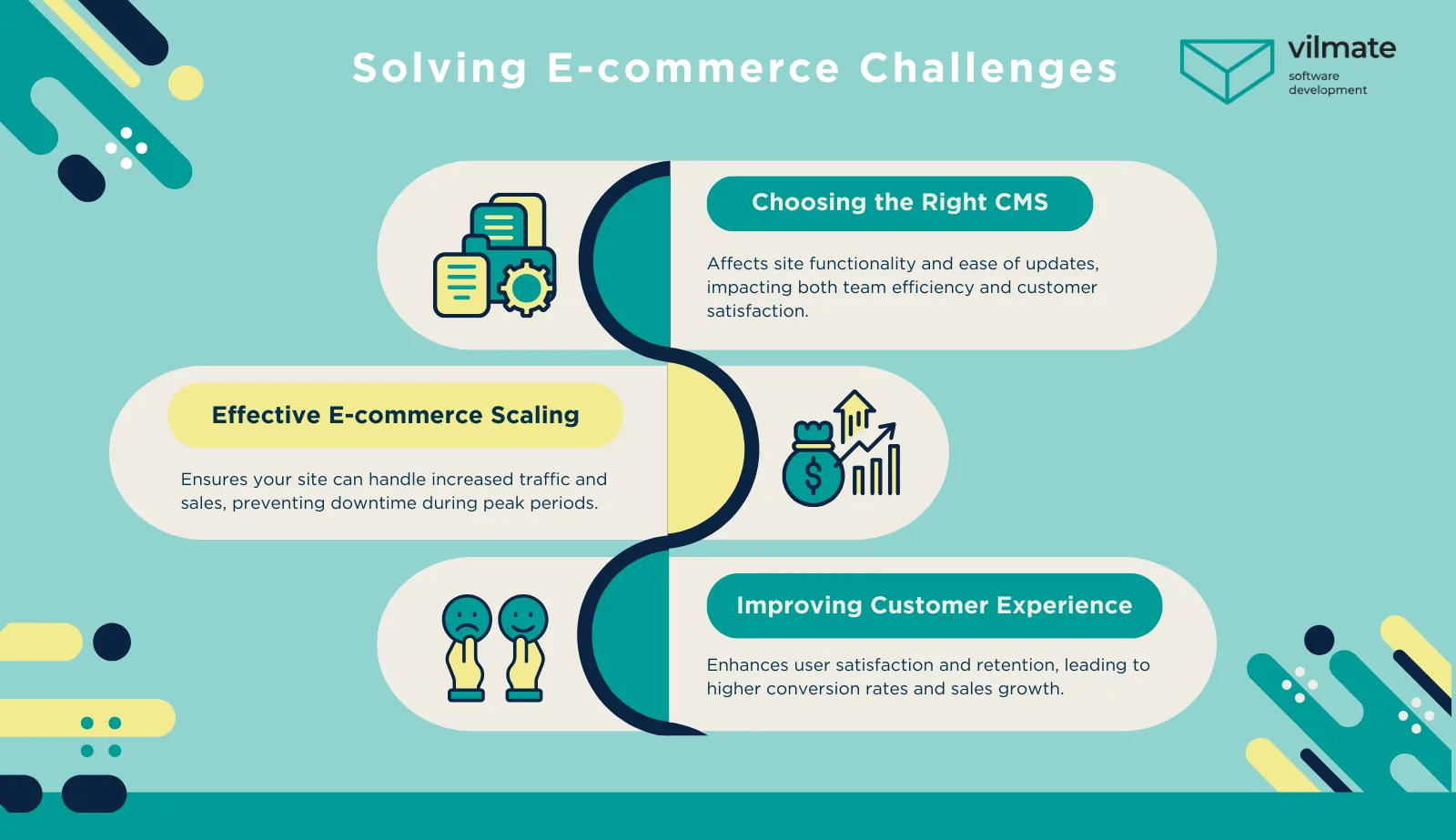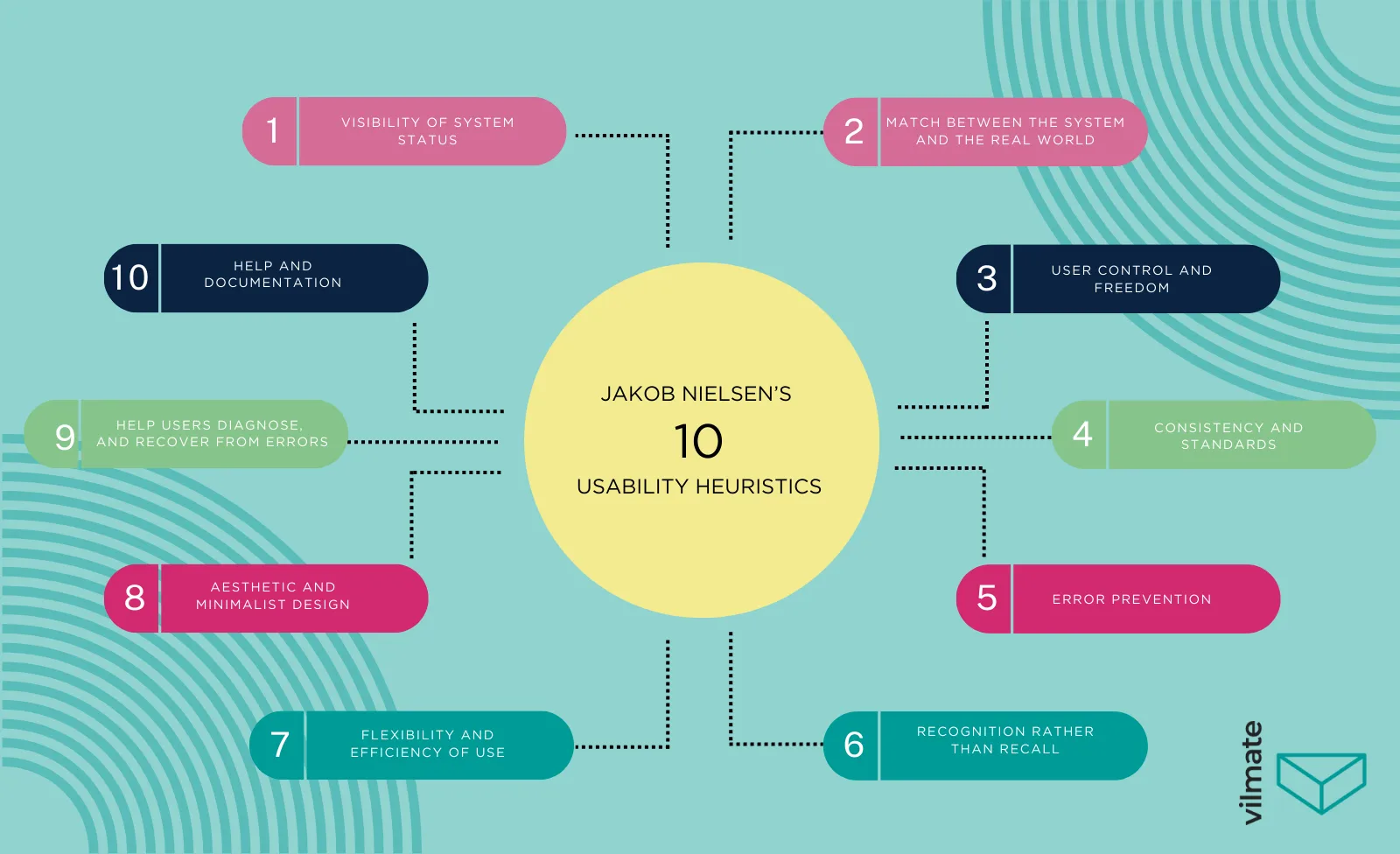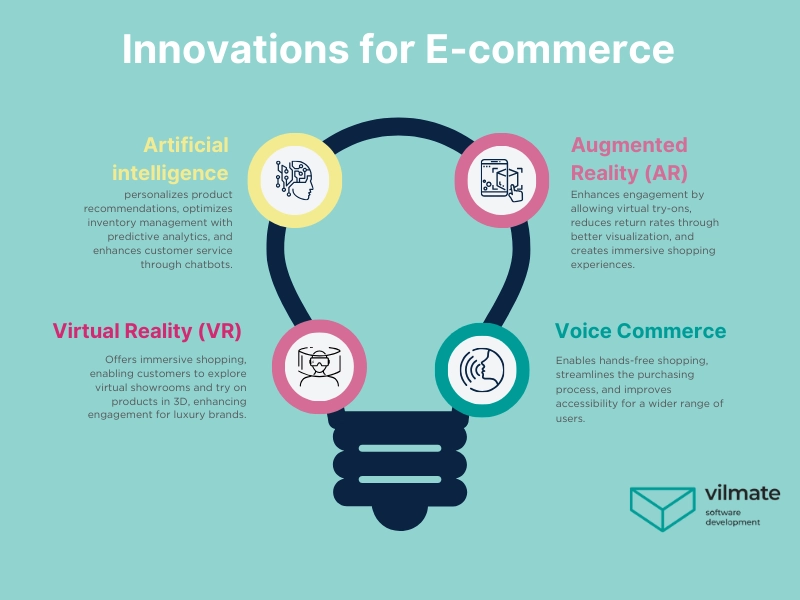E-Commerce Development: Navigating Challenges and Embracing Innovations
Vilmate expertisee-commercetechnologyE-commerce is one of the most competitive industries today, with businesses constantly vying for leadership. Companies rely on tools like marketing, excellent customer service, attractive offers, and, importantly, experimenting with new technologies. Any challenge arising during an e-commerce website or app development can slow progress. This is why it’s essential to anticipate and prevent potential issues.
Whether you already have an e-commerce site or are just starting your online business, it’s useful to be aware of common development problems and the most promising innovations in the industry.
At Vilmate, our team has worked on numerous e-commerce projects, gaining valuable experience and insights. We’ve encountered challenges and found solutions. With the help of our CTO, Igor Bagayev, we’ll share some of the most common obstacles and highlight the latest technologies that can help you stay ahead of your competition.
Challenges in E-commerce Development: Vilmate’s Experience

If you’re building an online store from scratch, you probably won’t face many major issues. Contact a company with experienced specialists who can develop your e-commerce site from start to finish. In fact, you’ve already found one—Vilmate. Our team can handle projects of any size and will ensure everything is done smoothly and correctly.
However, things can get more complicated if you already have a retail site that needs an upgrade. Once you decide to make changes, you may face several challenges that require time and careful solutions. Let’s explore some of these based on our experience.
Choosing a CMS for Your E-commerce Website
This task is important for both those building a new online store and those who already have an e-commerce website. The right CMS (Content Management System) will affect how easy it is to add features, how user-friendly the platform is for your team, and how convenient it is for your customers.
Here are some of the most popular CMS options for e-commerce:
- Shopify: A platform focused on creating online stores. It’s easy to use and offers a variety of themes and apps for customization.
- BigCommerce: An all-in-one platform for building online stores, supporting various payment and shipping methods.
- Magento: A powerful e-commerce platform ideal for medium and large businesses. It provides great flexibility and many customization options.
- WooCommerce: A customizable, open-source platform built for WordPress, offering flexibility and a wide range of plugins for e-commerce functionality.
- Salesforce Commerce: A robust platform designed for large enterprises, offering advanced features for managing multi-channel retail and extensive customer engagement capabilities.

Each CMS offers different levels of customization and features, so the choice depends on your business needs. We recommend well-established platforms like BigCommerce and Shopify.
If you already have an e-commerce site that needs updates or improvements, it’s likely running on one of these CMS platforms. If you can’t reach the original developers, transferring the project to a new IT company might be tricky. That’s why it’s essential to gather as much information as possible about your online store’s development and avoid putting all the responsibility on one person or team.
Our CTO also shared a case Vilmate handled, which faced similar challenges.
Igor Bagayev: We were approached by clients with a large, older e-commerce site that was constantly running into issues. Customers and staff experienced bugs in production, and some features were poorly implemented or didn’t work at all.
The clients thought the issue was with their BigCommerce CMS and wanted to switch to a more modern platform like Shopify. At the same time, their contract with the original development team was ending. Vilmate’s specialists conducted a full site audit and found many problems. It became clear that the issue wasn’t with BigCommerce, one of the best platforms on the market, but with the poor quality of the code.
We strongly advised against migrating to a new CMS for several reasons:
- BigCommerce was a better fit for the client’s existing site, with its features and structure.
- Considering that the original development took around 4 years, rewriting the site’s code would likely require an additional 2-3 years.
- Migration would lead to changes in the URL format and key modules, resulting in a loss of SEO rankings and content. Recovering from this would take a long time.
- Due to security measures, transferring user passwords to the new platform would be impossible. This situation would mean that all customer login details would be lost, preventing them from accessing their accounts. As a result, users would be forced to re-authorize, leading to frustration and a drop in conversions.
We presented the client with three options. Plan A was to keep the site on existing architecture and have our specialists gradually fix the issues and bugs. Plan B was to move the site to BigCommerce’s more modern front-end platform, BigCommerce Catalyst. Plan C was to migrate the site to Shopify, which would involve addressing all the challenges that came with it.
We recommended the second option as a balanced compromise between migrating to a modern, flexible platform and preserving the current product and user database structure. An added benefit was that it required minimal staff training, as they were already familiar with the BigCommerce ecosystem.
As you can see, choosing the right platform is crucial. For those starting an online business, choosing the best solution from the start is important. For large e-commerce sites, the decision to switch platforms must be thoroughly considered. It’s essential not only to compare the platforms but also to understand how the migration process will unfold and what it will mean for the existing customer base. With the right specialists, the best path forward can be determined.
We hope this information helps you create the right plan. Now, let’s move on to the next topic.
The Right Approach to Scaling
Scaling is essential for both new e-commerce sites and long-established projects. Planning for growth from the start is crucial when building a new retail site. If you overlook this, you could face problems like performance issues, difficulties adding new features, and challenges with system integration.
Igor Bagayev: We were approached by clients whose e-commerce site was growing in popularity. With several major holidays ahead—Thanksgiving, Black Friday, Halloween, and Christmas—they were unsure if their site’s architecture could handle the expected traffic surge.
We evaluated the site’s current structure and identified key areas that might cause problems during peak traffic. It was crucial to understand how much traffic and how many orders the site would receive and how to prepare it for the upcoming load.
The main challenge was the limited time—we had only a few months to complete the work. Rushing this process can be risky, and issues could arise at critical times. Without Vilmate’s experienced team, this likely would have happened.
We strongly advise planning for these moments early and scaling your site in time to avoid losing customers during high-demand periods. There’s also another issue that can lead to lost customers, which we’ll discuss next.
Delivering a Great Customer Experience
A satisfied customer leads to strong sales. Users should be able to find everything they need on your website within seconds; otherwise, you risk a high bounce rate.
Creating a user-friendly UI/UX design and ensuring effective site search functionality is essential.
When Vilmate takes on an existing site, our design team conducts a heuristic evaluation based on Jakob Nielsen’s 10 usability heuristics to ensure information is easily accessible. Overall, users should always know what will happen after they click on any element on the screen.

Many people underestimate the importance of search functionality on a website, which is a mistake.
Igor Bagayev: In our work on e-commerce sites, we often see poor search performance that may not be obvious to company staff. Our analysis found that customers usually leave the site without contacting support simply because they cannot quickly find their desired products. Our specialists know how to set up search algorithms effectively, and we have done this successfully on many projects. Recently, we have been able to integrate artificial intelligence into search functions, producing incredible results.
Speaking of AI integration, we promised to discuss the innovations that Vilmate specialists can offer for both new and existing e-commerce projects. Let’s explore that next.
Innovations We Offer for E-commerce
E-commerce is a field that is always open to experimentation. Now is the perfect time to adopt new technologies to improve your business. What can we recommend for integration? Artificial intelligence (AI) takes the lead. Let’s look at how it can benefit business processes.
- Enhanced Search: AI makes website search more intuitive by using natural language processing, recommendation systems, and auto-completion for queries.
- Personalized Service: AI creates a tailored experience by offering product recommendations, chatbots for customer support, and personalized email campaigns.
- Process Automation: AI automates routine tasks such as inventory management, order processing, and pricing optimization.
- Data Analytics: AI collects and analyzes data on customer behavior, predicts demand, and evaluates marketing strategies.
- Logistics: AI improves logistics by optimizing delivery routes, automating warehouse operations, and predicting delays.
Using artificial intelligence in e-commerce enhances the customer experience and streamlines business processes, increasing revenue and competitiveness.

But AI isn’t the only innovation we can help you implement. Here are some additional technologies to consider:
- Augmented Reality (AR): AR in e-commerce offers exciting opportunities to improve user experience. With AR, customers can interact with products in a virtual space, allowing them to “try on” items like clothing or accessories before purchasing. For example, apps can use a smartphone’s camera to overlay images of products onto the real world, helping customers visualize how these items will look in their lives. Integrating AR can significantly reduce returns, as users can make more informed purchasing decisions.
- Virtual Reality (VR): VR provides a fully immersive experience, such as creating virtual showrooms where customers can explore and engage with products. This can be particularly effective for luxury brands, offering a unique way to experience the brand and products before making a purchase.
- Voice Commerce: This feature is gaining popularity due to the rise of voice assistants like Alexa and Google Assistant. These technologies allow users to make purchases by simply speaking commands. For instance, a customer might say, “Buy milk” or “Find new sneakers,” the system automatically processes the request, suggesting products and completing the order. This makes shopping more convenient and faster, especially for those who prefer voice commands over traditional typing. Implementing voice commerce requires optimizing website content and structure to ensure compatibility with voice search and improve product visibility.
Together, these technologies are transforming e-commerce, creating a more interactive, convenient, and reliable customer experience. Contact Vilmate to develop or enhance your e-commerce site. We are confident we can find the right solutions for your business to thrive and address any challenges you may face.




